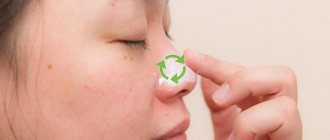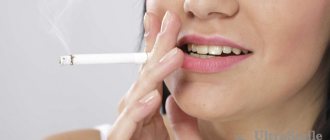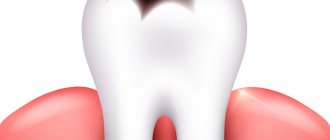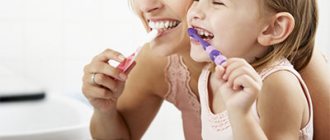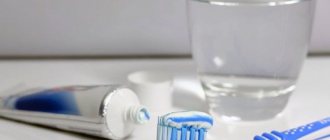Why do you need to brush your teeth?
Oral hygiene is not only a matter of aesthetics. It is due to medical reasons. A plaque constantly forms on the enamel, consisting of: • food particles; • saliva; • waste products of microorganisms inhabiting the oral cavity.
The process of plaque deposition does not depend on whether a person ate in the interval between brushings. If it is not removed, over time it turns to stone. Contamination not only creates a cosmetic defect. Deposits contribute to the violation of the integrity of the enamel. Pathogenic bacteria penetrate into the resulting cracks and actively multiply under conditions of poor hygiene. This is how caries begins with all the known consequences. These microorganisms also attack the gums. In people who neglect to brush their teeth, gingivitis becomes chronic. If the inflammation is not treated, complications in the form of periodontitis and periodontal disease are possible. As a result, the root no longer holds in the socket and the tooth falls out.
How to brush your teeth correctly?
It is a mistaken idea that everyone can do this. There are a number of rules, many of which are either unknown or ignored. However, only compliance with them guarantees effective cleaning of the enamel: • Carrying out hygiene procedures not only at home, but also at the dentist. • Rational selection of brushes and paste. • Using the optimal teeth brushing method. • Using dental floss, brushes and mouthwash. • Taking into account the condition of the gums, the presence of braces and dentures. • Compliance with the rules for storing, cleaning and replacing brushes.
Tablets for determining plaque will help you understand whether you have achieved your goal. They demonstrate whether unwanted deposits are present on the enamel. They also suggest which areas are not being worked through carefully enough.
Expiration dates for popular manufacturers
With the development of modern technologies, in many cases it has been possible to increase the shelf life , which previously did not exceed 12 months.
Popular manufacturers state the following terms (from the date of manufacture):
- for the brands Colgate (Colgate), Blend-a-Med (Blendamed), Lacalut (Lakalyut), Aquafresh (Aquafresh) and New Pearl - 3 years ;
- for Splat – 2 years .
Find out how to determine the expiration date of cosmetics using the batch code here.
Choosing a toothbrush
To completely clean the enamel from plaque, you need to choose a suitable brush. The easiest way to do this is by material. There are two options here - natural and synthetic. It is better to give preference to the latter, since they are quite elastic, and the tips of the hairs are usually rounded, which is safer for the gums. Bacteria multiply faster on natural materials.
In terms of the stiffness of the bristles, toothbrushes are: • Soft. They are best taken for children, adolescents and people suffering from gingivitis. • Average. A universal option for people without dental problems. • Tough. They help fight hard plaque and can be used only when indicated.
The configuration of the bristles should be discussed with your dentist. It will tell you where more sediment collects. For example, if you need to better work on the necks of teeth, bristles collected in bunches can handle this.
Which indicator should you choose?
Manufacturers of the most famous indicators at the moment, in the line of which you can find both liquid products and indicators in tablet form:
- Miradent;
- Curaprox.
The production volume can be different, so it’s easy to choose the one that’s right for you: a package of tablets can contain from 6 to 250 pieces. A bottle of liquid - from 10 to 500 milliliters.
Some manufacturers provide a separate line of products for children, adding flavors to the solution, for example, chewing gum, which kids like.
Pasta selection
Pastes are hygienic, preventive and therapeutic. The first ones solve the only problem - clean the enamel. The latter, due to the antiseptic component, help prevent the development of gingivitis and caries. Still others are prescribed by dentists for therapeutic purposes; it is better not to use them on your own.
Toothpastes are also distinguished according to the results of use: • whitening - slightly lighten the enamel, but you should not expect drastic changes from them; • strengthening – contain fluoride, good for enamel health; • desensitizing - reduce sensitivity; • anti-inflammatory - help with gingivitis.
Abrasiveness characterizes the degree of impact on plaque. The average value of this indicator is from 50 to 80. Higher values can be taken occasionally to lighten teeth. Lower abrasiveness is indicated for sensitive enamel and gums.
Proper brushing of teeth: sequence of movements
For hygiene purposes, you need to accustom yourself to a certain sequence of movements.
After squeezing the paste onto the brush, you must: • apply it to the teeth at an angle of 45 or 90 degrees; • pass each one 3-4 times in the direction from the gums to the cutting edge; • treat chewing surfaces with circular movements; • Allow at least 30 seconds of brushing for each half of the jaw. Depending on the location of the brush and the direction of movement, there are three methods of brushing teeth. The most famous (90 degree brush, top to bottom movements) is the Leonard method.
The Bass method involves choosing an angle of 45 degrees and making vibrating movements. It is good because the bristles penetrate into the interdental spaces and partially work out the contact surfaces. With the Fones method, an angle of 90 degrees is taken and the brush moves in a circle. This further massages the gums, which improves blood circulation and protects against inflammatory processes.
What do GOSTs say?
The regulatory document establishing toothpaste standards in the territory of the countries of the Customs Union is GOST 7983-99 “Toothpastes. General technical conditions".
According to it, the shelf life for each specific item is set by the manufacturer.
GOST specifies the necessary storage conditions for toothpaste: air temperature from 0 to 25°C, exposure to direct sunlight and location near heating devices is not allowed.
The regulatory document establishing toothpaste standards in the territory of the countries of the Customs Union is GOST 7983-99 “Toothpastes. General technical conditions".
Additional oral cleansing
Oral hygiene is not limited to two rows of teeth. For complete cleansing it is necessary to treat: • Interdental spaces. Dental floss or a brush will help remove plaque. • Language. To do this, use the relief surface of the back of the toothbrush or a special scraper. • Gums. They are partly cleaned with a brush: at an angle of 45 degrees, the bristles approach the edge and capture deposits. Rinse aid also helps. • Cheeks. You can go over them with the back of the brush, but they require more rinsing.
You need to start by removing the largest food debris. To do this, just rinse your mouth with water. Then comes the turn of fragments stuck in the interdental spaces - this is where floss comes to the rescue. Now you can take up the brush with the paste. Rinse aid is used last - to create a protective layer.
Storage after opening the tube
Storing the paste in the bathroom will be more reliable if you place it vertically, with the tip of the tube down. This minimizes the interaction between the contents of the tube and the air. This storage method will somewhat slow down the oxidation process.
- It is more correct to store tubes of paste in a special closed cabinet designed for the bathroom.
- Do not forget to screw the tube cap tightly after each use of the paste, otherwise the harmful effects of oxygen on the cleaning product cannot be avoided. And if, before using the product, it turns out that the tube was not closed tightly, it is better to squeeze out the upper part and throw it away.
- After opening the tube, the composition should not be stored longer than 2 - 6 months, and for children's paste this time is reduced to 1 month.
- Most often, manufacturers indicate expiration dates for toothpastes after opening. To make it easier to find, there is an image of an open jar on the product box.
How to brush your teeth with gingivitis?
Inflammation of soft tissues is not a reason to neglect hygiene. On the contrary, the more often cleansing is done, the less chance bacteria have to support the inflammatory process.
However, you need to take precautions: • choose brushes with soft bristles (preferably rounded); • choose a paste with low abrasiveness and containing medicinal herbs; • give preference to the Bass method, and abstain from the Fones method until remission; • move your hand more carefully to avoid painful sensations.
Cleaning time should not be shortened, even if the procedure causes discomfort. Sometimes dentists even recommend increasing it. Inflammation of the gums is accompanied by the formation of pockets. Where their edges lag behind, stone grows with particular intensity. This place deserves more careful study.
Proper storage conditions
For unopened packaging, the rules are specified in GOST 7983-99.
Standard requirements for the conditions for keeping toothpaste include a temperature range from 0 to +25°C, protection from direct sunlight and location away from heating devices.
It is not recommended to store tubes that you will not use in the near future in the bathroom.
The tube cap should be tightly closed to avoid unnecessary contact with air, and to minimize it, it is recommended that the tube be kept in a vertical position with the cap down.
If these conditions are met, the shelf life for a sealed tube will be from two to three years .
In our article you will find information about decoding product barcodes.
By unsealing the tube cap, you can count on maintaining the characteristics of the paste for two to six months , and for children - no more than one month.
How to clean dental structures?
Dental structures in the mouth make adjustments to the cleaning process: • Crowns. More attention should be paid to the area where the gums come into contact with the prosthesis. • Bridges. A round mono-tuft brush is more suitable for them. • Veneers. The teeth where they are installed cannot be treated with floss. The ban does not apply to other methods. • Braces. The space under the arch and the area adjacent to the enamel is cleaned with brushes.
In all of the above cases, it is necessary to use an irrigator. Conventional cleaning devices are not able to penetrate all the places where plaque accumulates. There are no barriers for water. Under the pressure set by the device, it knocks out stuck food fragments, preventing them from decomposing or turning into stone.
How do plaque tablets work?
We usually contact a dentist to assess the quality of oral hygiene. It identifies areas that are not cleaned effectively and makes recommendations for replacing the paste or brush. But in between visits to the clinic, you can cope without the help of a doctor.
Special tablets, developed by the Swiss company CURADEN, will help with this. They are part of the CURAPROX range of dental care products. Determination of plaque occurs as follows: • the tablet is diluted in water; • after brushing, a person rinses his mouth with this solution, distributing it over his teeth; • deposits are stained, clean enamel remains intact.
The tablets also help distinguish soft plaque from tartar. The first one becomes pink, the second one becomes dark blue. This way you can understand whether it’s time to go for ultrasonic cleaning.
Everything, to the last drop
A hair clip helps squeeze out the toothpaste completely. Doctors do not advise skimping on toothpaste - it should be used in sufficient quantity, at least twice a day, and choose a product of proper quality. And good quality is not cheap. That's why everyone wants to use every last drop of toothpaste so they can throw away the empty tube. There are several tricks for this:
- Special devices. Manufacturers of various ingenious household items have long understood the desire of housewives to use the contents of tubes to the last drop. Therefore, there are various devices on sale that help squeeze out the paste to the end.
- Tricks. You can use a regular hair clip or clothespin. Pin this thing to the end of a tube of toothpaste, and then wrap the end, wrapping it around a clothespin or clip.
- Keep the toothpaste with the cap down - then the paste composition will always be closer to the hole, and will not accumulate at the end of the tube.
Consequences of not brushing your teeth properly
Proper and timely cleaning of dental plaque is protection against oral diseases.
If you neglect it, the consequences will only increase: • Tartar forms. It gives off an unpleasant odor. If you do not carry out ultrasonic cleaning, it will become a favorite place for bacteria. • Bacteria will destroy the enamel. The abundance of pathogenic microorganisms quickly leads to caries. • Bacteria will cause your gums to become inflamed. Soft tissues are no less sensitive to them than hard ones. And this means bleeding, swelling and an unpleasant odor.
Possible complications are also worth mentioning. Caries develops into pulpitis, which requires removal of the nerve. This deprives the tooth of nutrition, as a result of which it sooner or later collapses. Progressive gingivitis is fraught with periodontitis and periodontal disease. Lack of oral hygiene leads to tooth loss. Restoring them is more expensive than the cost of a brush, paste and professional cleaning. Therefore, it is better to remember these simple rules and follow them.
